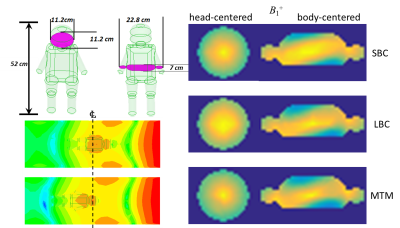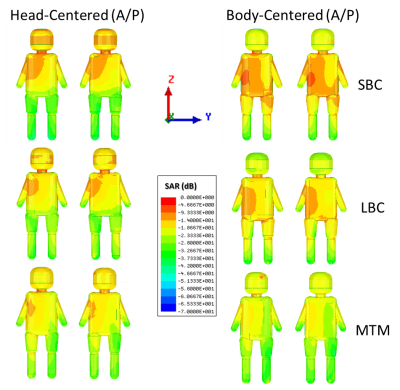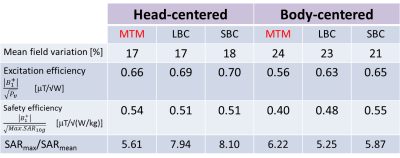4298
Metamaterial Bore Liners as High-Field Body Transmit Coils: Advantages Over Standard Birdcage Coils1Electrical and Computer Engineering, University of Alberta, Edmonton, AB, Canada, 2Oncology, University of Alberta, Edmonton, AB, Canada, 3Medical Physics, Cross Cancer Institute, Edmonton, AB, Canada
Synopsis
Simulations are presented of a negative-permittivity metamaterial bore liner designed to perform volume excitation at 200 MHz. The liner offers performance comparable to that of birdcage coils in terms of both field homogeneity, sensitivity and SAR, while allowing operation at frequencies beyond those where birdcage coils operate reliably.
Introduction
Uniform RF excitation is a challenge in the body with any setup at high frequencies because of the short wavelength. Traditional body coils are convenient at lower field strengths because they do not require subject-specific adjustments, but at high frequency they are highly sensitive to dielectric loading. Body coils are also costly to build because they contain expensive components like high-voltage capacitors, and require tuning and balancing on the bench for optimal operation.
The alternative that is explored in this work is to line the bore of the MR system with a metamaterial that can be excited to produce fields that are similar to those produced by traditional body coils. Metamaterials are periodic structures that provide effective bulk permeability and permittivity responses beyond those found in nature. Their periodic arrangement facilitates modular construction using automated PCB techniques and the distributed nature implies an inherent general robustness to manufacturing tolerances.1 A frequency of 200 MHz (4.7 T) was chosen, which is beyond the preferred range of suitability of traditional resonators (≤3T), and below frequencies at which their performance would suffer greatly (≥7T), where travelling-wave effects can also become dominant.2,3
Methods
Three geometries were simulated in Ansys HFSS, a finite-element-method full-wave electromagnetic simulator:
- A small hybrid birdcage (12 sections, 41.5 cm long and 36.4 cm in diameter), made resonant at 200 MHz using 46.2 pF end-ring capacitors and 2⨉50 pF capacitors on each rung, and driven in quadrature using two lumped ports at each end ring.
- A large hybrid birdcage (16 sections, 42 cm long and 52 cm in diameter), made resonant at 200 MHz using 28.5 pF end-ring capacitors and 2⨉100 pF capacitors on each rung, and driven in quadrature using four lumped ports at each end ring (Fig. 1).
- The metamaterial liner (Fig. 3) was 160 cm in length, 2 cm in thickness, and its negative permittivity observes a Drude dispersion4 attaining values of approximately -0.118 at the frequency of interest (200 MHz).
A driven modal solution was used with discrete, high accuracy sweep, and meshing was adaptive with a maximum segment length of 3 cm. All models included a cylindrical perfect electrical conductor boundary 160 cm in length and 56 cm in diameter. The empty bore is thus below cutoff. For the birdcage coils the ends of the cylinder were also perfect electrical conductor, while for the metamaterial liner they were wave ports (TE11 mode, circularly polarized), one of which was driven. Cylindrical sections 80 cm in length and 140 cm in diameter were used between the lined bore and wave ports to allow gradual transitions between the fields of the ports and lined bore (they are not exactly TE11). An anthropomorphic model of an infant (uniform 𝛆r = 76, 𝜎 = 0.8 S/m) was included as a load (Fig. 3). A larger body was not used because the large hybrid birdcage was too sensitive to such loads at this frequency. From the simulations, comparisons were made of SAR and B1+ field homogeneity, as well as excitation efficiency and safety efficiency5 (defined in Table 1).
Results and Discussion
Field homogeneity achieved by the metamaterial liner is equivalent to that achieved by the birdcage coils (Figs. 1–3 and Table 1) both in the empty bore and with a load. The SAR performance is also comparable (Fig. 4 and Table 1), with the metamaterial liner outperforming the birdcage coils in the head-centered case (lower SAR hotspots and higher safety efficiency).
While it is a considerable challenge to operate a large birdcage at 200 MHz with the same stability achieved at lower frequencies, the metamaterial liner is robust and can be readily implemented using inexpensive PCB techniques and retrofitted into any existing scanner bore. Indeed, a 20⨉ scaled-down version was demonstrated6, including the theory required to operate at frequencies well below the natural cutoff of the bore for use at current clinical field strengths (1.5–3 T).
Conclusion
Our simulations confirm that a metamaterial bore liner could function as a high-field TX body coil. While similar to travelling-wave MRI2, the liner does not suffer from low sensitivity. When compared to standard birdcage coils the liner offers better or comparable field homogeneity, lower SAR hotspots and higher safety efficiency in the head-centered position. Transmit efficiency is also comparable, while offering 69% more clear space in the bore than the small birdcage.
In conclusion, metamaterial liners are a promising alternative to traditional volume coils, especially at high field where volume excitation is intrinsically challenging. Future work includes constructing a full-scale prototype with an efficient feed network for quadrature drive.
Acknowledgements
We thank the Natural Sciences and Engineering Research Council (Canada) for funding.References
- R Aylo, G Nehmetallah, H Li, PP Banerjee. Multilayer periodic and random metamaterial structures: analysis and applications. IEEE Access, 2, 437-450 (2014).
- DO Brunner, N De Zanche, J Fröhlich, J Paska, KP Pruessmann. Travelling-wave nuclear magnetic resonance. Nature, 457, 944-998 (2009).
- JG Pollock, N De Zanche, AK Iyer. Traveling-Wave MRI at Lower B0 Field Strengths Using Metamaterial Liners. ISMRM #2792 (2012).
- JG Pollock, AK Iyer. Below-cutoff propagation in metamaterial-lined circular waveguides. IEEE Transactions on Microwave Theory and Techniques 61 (9), 3169-3178 (2013).
- M Kozlov, R Turner. Influence of Shield Distance on RF Transmit Performance for a 7T Multi-channel MRI Loop Array. Proc. Progress In Electromagnetics Research Symposium, pp. 255–259 (2012).
- JG Pollock, AK Iyer. Experimental verification of below-cutoff propagation in miniaturized circular waveguides using anisotropic ENNZ metamaterial liners," IEEE Trans. Microwave Theory Tech., vol. 64, no. 4, pp. 1297-1305 (2016).
Figures




